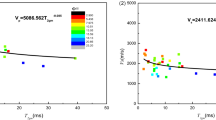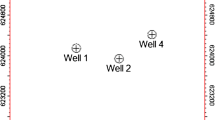Abstract
Gas saturation is an essential parameter in natural gas reservoir evaluation. As complex pore structure reduces the resistivity contrast between gas and water layers, gas saturation is difficult to calculate accurately by rock resistivity in low-porosity and low-permeability reservoir. The gas saturation is positively correlated with the relative value of compressional wave (P wave) slowness’ square based on the rock acoustic wave theory. In this study, rock samples are divided into four types of pore structures according to nuclear magnetic resonance (NMR) data. Relation models between the gas saturation and the relative value of P wave slowness’ square are established for each type. New models are further applied in field logging data in low-porosity and low-permeability gas-bearing sandstone reservoirs. The result shows that the new models calculated gas saturation is in good agreement with the gas-producing test. This paper provides a new way of qualitative evaluation of gas saturation. It enriches effective evaluation methods in low-porosity and low-permeability gas-bearing reservoirs with non-electrical logging data.










Similar content being viewed by others
References
Amalokwu K, Best AI, Chapman M, Minshull TA, Li X (2015) Partial gas saturation effects on P-wave anisotropy in porous rock with aligned fractures. Seg Technical Program Expanded Abstracts
Brie A, Pampuri F, Marsala AF, et al. (1995) Shear sonic interpretation in gas bearing sands. SPE Annual Technical Conference and Exhibition. Dallas, Texas: Society of Petroleum Engineers
Chen Z, Wang X, Zha M, Zhang Y, Cao Y, Yang D, Wu K, Chen Y, Yuan G (2016) Characteristics and formation mechanisms of large volcanic rock oil reservoirs: a case study of the carboniferous rocks in the Kebai fault zone of Junggar Basin, China. AAPG Bull 100(10):1585–1617
Dehua H, Amos N, Dale M (1986) Effects of porosity and clay content on wave velocities in sandstones. Geophysics, 1986 51(11):2093–2107
Dugarov GA, Duchkov AA, Duchkov AD, Drobchik AN (2019) Laboratory validation of effective acoustic velocity models for samples bearing hydrates of different type. Journal of Natural Gas Science and Engineering 63:38–46
Dutta NC (2012) Attenuation and dispersion of compressional waves in fluid-filled porous rocks with partial gas saturation (white model)—part i: biot theory. Geophysics 44(11):1777
Dutta NC, Seriff AJ (1979) On White’s model of attenuation in rocks with partial gas saturation. Geophysics 44(11):1806–1812
El-Husseiny A, Vega S, Nizamuddin S (2019) The effect of pore structure complexity and saturation history on the variations of acoustic velocity as function of brine and oil saturation in carbonates. J Pet Sci Eng 179:180–191
Endres AL, Knight R (1991) The effects of pore-scale fluid distribution on the physical properties of partially saturated tight sandstones. J Appl Phys 69(2):1091–1098
Fattahi H, Karimpouli S (2016) Prediction of porosity and water saturation using pre-stack seismic attributes: a comparison of Bayesian inversion and computational intelligence methods. Comput Geosci 20(5):1075–1094
Gaowei H, Yuguang Y et al (2014) Acoustic response of gas hydrate formation in sediments from South China Sea. Mar Pet Geol 52:1–8
Gassmann F (1951) Elastic waves through a packing of spheres. Geophysics 16(4):673–685
Gist GA (1994) Interpreting laboratory velocity measurements in partially gas-saturated rocks. Geophysics 59(7):1100–ll09
Haines SS, Collett T, Boswell R, Lim TK, Okinaka N, Suzuki K, Fujimoto A (2020). Gas hydrate saturation estimation from acoustic log data in the 2018 Alaska North Slope Hydrate-01 Stratigraphic Test Well. Proc. ICGH-10, Singapore
Han DH, Batzle ML (2004) Gassmann’s equation and fluid-saturated effects on seismic velocities. Geophysics 69(2):398–405
Hongxia M, Wei S, Wu P (2015) Application of nmr technology on test of movable fluid saturation of tight sandstone gas reservoir. Adv Mater Res 1092-1093:1361–1365
Hosseini SE, Andwari AM, Wahid MA, Bagheri G (2013) A review on green energy potentials in Iran. Renew Sust Energ Rev 27:533–545
Jixin D et al. (2004). Analysis of the velocity anisotropy and its affection factors in shale and mudstone. Chinese J Geophys 47(5): 862 868, doi: 10.3321/j. issn: 0001–5733. 2004, 05, 018.(In Chinese abstract)
Junbao W, Zhenzhong R, Zhanping S, Runke H, Yang T (2019) Study of the effect of micro-pore characteristics and saturation degree on the longitudinal wave velocity of sandstone. Arab J Geosci 12(13):1–11
Junchang S, Yang Z et al (2011) Study on distribution law of irreducible water and gas saturation of tight sandstone gas reservoir. Shenzhen Daxue Xuebao (Ligong Ban)/Journal of Shenzhen University ence and Engineering 28(5):377–383 (In Chinese abstract)
Kadkhodaie-Ilkhchi R, Moussavi-Harami R, Rezaee R, Nabi-Bidhendi M, Kadkhodaie-Ilkhchi A (2014) Seismic inversion and attributes analysis for porosity evaluation of the tight gas sandstones of the whicher range field in the Perth basin, Western Australia. Journal of Natural Gas Science & Engineering 21:1073–1083
Keys RG, Xu S (2002) An approximation for the xu-white velocity model. Geophysics 67(5):1406–1414
Khaksar A, Grifiths CM, Mccann C (1999) Compressional- and shear-wave velocities as a function of confining stress in dry sandstones. Geophys Prospect 47:487–508
King MS, Marsden JR, Dennis JW (2000) Biot dispersion for P and S wave velocity in partially and fully saturated sandstone. Geophysical Prospecting, 2000 48(6):1075–1089
Kun L et al (2017) A new method for estimating the free-to-adsorbed ratio in shale gas reservoirs using acoustic amplitude attenuation and porosity. J Geophys Eng 14(5):1042–1051
Lee MW, Waite WF (2008) Estimating pore-space gas hydrate saturations from well log acoustic data. Geochem Geophys Geosyst 9(7)
Li H, Zhang J (2018) Well log and seismic data analysis for complex pore-structure carbonate reservoir using 3D rock physics templates. J Appl Geophys 151:175–183
Xiao Liang, Mao Zhiqiang & Xie Xiuhong. 2016. A new method of evaluating tight gas sands pore structure from nuclear magnetic resonance (NMR) logs. Egu General Assembly Conference. EGU General Assembly Conference Abstracts
Lucier AM, Hofmann R, Bryndzia LT (2011) Evaluation of variable gas saturation on acoustic log data from the Haynesville shale gas play, NW Louisiana, USA. Lead Edge 30(3):300–311
Mahmood MF, Ahmad Z, Ehsan M (2018) Total organic carbon content and total porosity estimation in unconventional resource play using integrated approach through seismic inversion and well logs analysis within the Talhar shale, Pakistan. Journal of Natural Gas Science and Engineering 52:13–24
Mollison RA, Schon JS, Fanini ON, Kreigshauser B, Meyer WH, Gupta PK (1999). A model for hydrocarbon saturation determination from an orthogonal tensor relationship in thinly laminated anisotropic reservoirs
Morgan EC, Vanneste M, Lecomte I et al (2012) Estimation of free gas saturation from seismic reflection surveys by the genetic algorithm inversion of a P wave attenuation model [J]. Geophysics 77(4):R175–R187
Na'imi SR, Shadizadeh SR, Riahi MA, Mirzakhanian M (2014) Estimation of reservoir porosity and water saturation based on seismic attributes using support vector regression approach. J Appl Geophys 107:93–101
Neithalath N, Marolf A, Weiss J, Olek J (2005) Modeling the influence of pore structure on the acoustic absorption of enhanced porosity concrete. J Adv Concr Technol 3(1):29–40
Sambo, C. H. , Hermana, M. , Babasari, A. , Janjuhah, H. T. , & Ghosh, D. P. . (2018). Application of artificial intelligence methods for predicting water saturation from new seismic attributes. Offshore Technology Conference Asia
Sams MS, Andrea M (2001) The effect of clay distribution on the elastic properties of sandstones. Geophys Prospect 49(1):128–150
Siggins AF, Dewhurst DN (2003) Saturation, pore pressure and effective stress from sandstone acoustic properties. Geophys Res Lett 30(2)
Smith GC, Gidlow PM (1987) Weighted stacking for rock property estimation and detection of gas. Geophys Prospect 35(9):993–1014
Sun YF, Massaferro JL, Eberli G, Teng YC (2002). Quantifying the effects of pore structure and fluid saturation on acoustic wave velocity in carbonates. In Theoretical And Computational Acoustics 2001 (pp. 335–347)
Tamaki M, Suzuki K, Fujii T, Sato A (2016) Prediction and validation of gas hydrate saturation distribution in the eastern Nankai trough, Japan: geostatistical approach integrating well-log and 3D seismic data. Interpretation 4(1):SA83–SA94
Tianyang L et al (2020) Numerical study of pore structure effects on acoustic logging data in the borehole environment. Fractals 28(03):2050049
Uyanik O (2019) Estimation of the porosity of clay soils using seismic p- and s-wave velocities. J Appl Geophys 170:103832
Wang K, Li N (2008) Numerical simulation of rock pore-throat structure effects on nmr t2 distribution. Appl Geophys 5(2):86–91
Wenpeng S et al (2016) Experimental study of water saturation effect on acoustic velocity of sandstones. Journal of Natural Gas Science and Engineering 33:37–43
Wenrui S et al (2019) Application of dipole array acoustic logging in the evaluation of shale gas reservoirs. Energies 12(20):3882
White JE (1975) Computed seismic speeds and attenuation in rocks with partia1 gas saturation. Geophysics 40(2):224–232
Xie W, Yin Q, Guan W, Wang G, Lai J (2020) Estimating the relative permeability from the electrical parameters of sandstone with a complex pore structure. Energy&Fuels. 2020:34,14124–34,14131
Xie W, Yin Q, Wang G, Zhiyong Y (2021) Variable dimension fractal-based conversion method between the nuclear magnetic resonance T2 spectrum and capillary pressure curve. Energy&Fuels. 2021(35):351–357
Xiujuan W et al. (2010). Estimation of gas hydrate saturation based on resistivity logging and analysis of estimation error. Geoscience
Xu D, Jianmeng S, Jun L, Gao H, Xuefeng L, Wang J (2015) Experimental research of gas shale electrical properties by NMR and the combination of imbibition and drainage. J Geophys Eng 12(4):610–619
Yafei W (1999) Estimation of gas saturation using p-to-s converted waves. Seg Technical Program Expanded Abstracts 19(1):2484
Yan BJ, Yang X et al (2013) Rock physics model and gas saturation inversion for heterogeneous gas reservoirs. Chinese Journal of Geophysics Chinese Edition 56(5):1696–1706
Yuguang Y, Jian Z et al (2008) Experimental research on the relationship between gas hydrate saturation and acoustic parameters. Chin J Geophys 51(4):819–828
Zhao P, Sun Z, Luo X et al (2016a) Study on the response mechanisms of nuclear magnetic resonance (NMR) log in tight oil reservoirs. Chin J Geophys 2016(29):1927–1937. https://doi.org/10.6038/cjg20160535 (in Chinese abstract)
Zhao P, Mao Z, Huang Z et al (2016b) A new method for estimating total organic carbon content from well logs. AAPG Bull 100(8):1311–1327
Zhao P, Wang Z, Sun Z et al (2017) Investigation on the pore structure and multifractal characteristics of tight oil reservoirs using NMR measurements: Permian Lucaogou formation in Jimusaer sag, Junggar Basin. Mar Pet Geol 2017(86):1067–1081
Zhao P, Jinhua F, Shi Y et al (2020) Hydrocarbon saturation in shale oil reservoirs by inversion of dielectric logs. Fuel 2020(266):116934
Zhu L, Zhang C, Zhang C, Wei Y, Zhou X, Cheng Y, Huang Y, Zhang L (2018) Prediction of total organic carbon content in shale reservoir based on a new integrated hybrid neural network and conventional well logging curves. J Geophys Eng 15(3):1050–1061
Author information
Authors and Affiliations
Corresponding authors
Ethics declarations
Conflict of interest
The authors declare that they have no competing interests.
Additional information
Responsible Editor: Santanu Banerjee
Rights and permissions
About this article
Cite this article
Xie, W., Yin, Q., Wang, G. et al. Modeling of gas saturation based on acoustic wave and pore structure classification and application in the low-porosity and low-permeability reservoir. Arab J Geosci 14, 917 (2021). https://doi.org/10.1007/s12517-021-07331-9
Received:
Accepted:
Published:
DOI: https://doi.org/10.1007/s12517-021-07331-9




